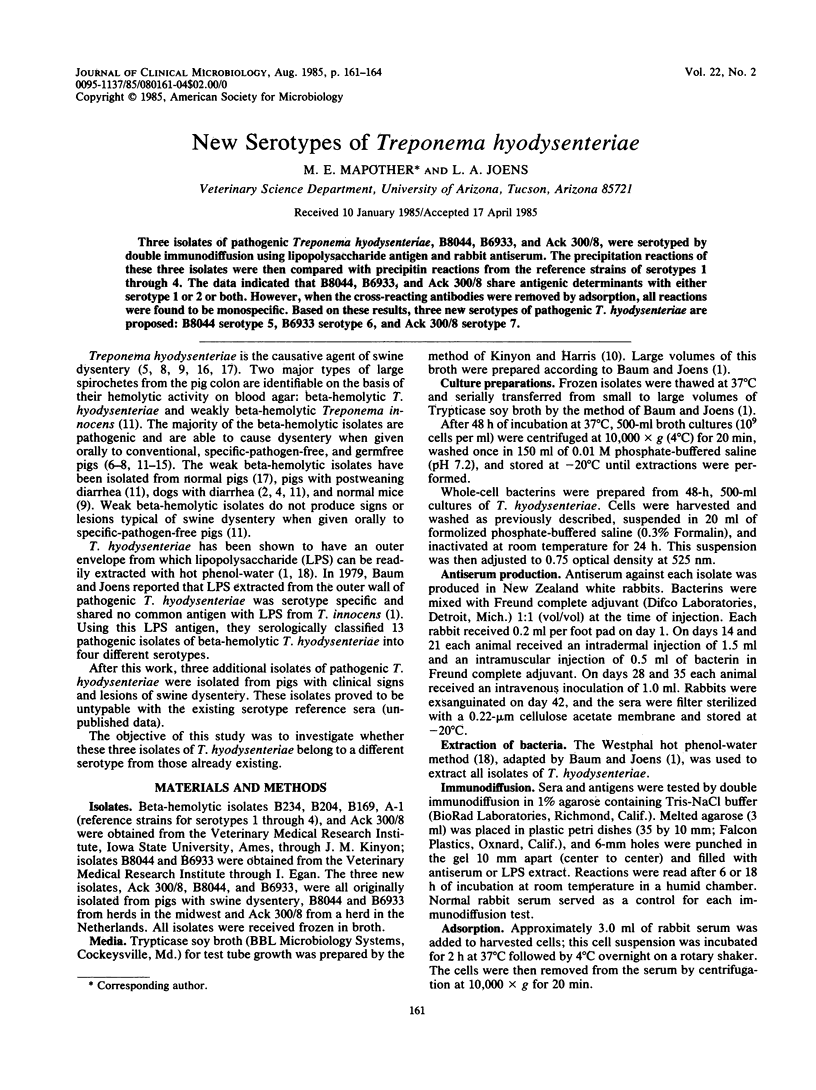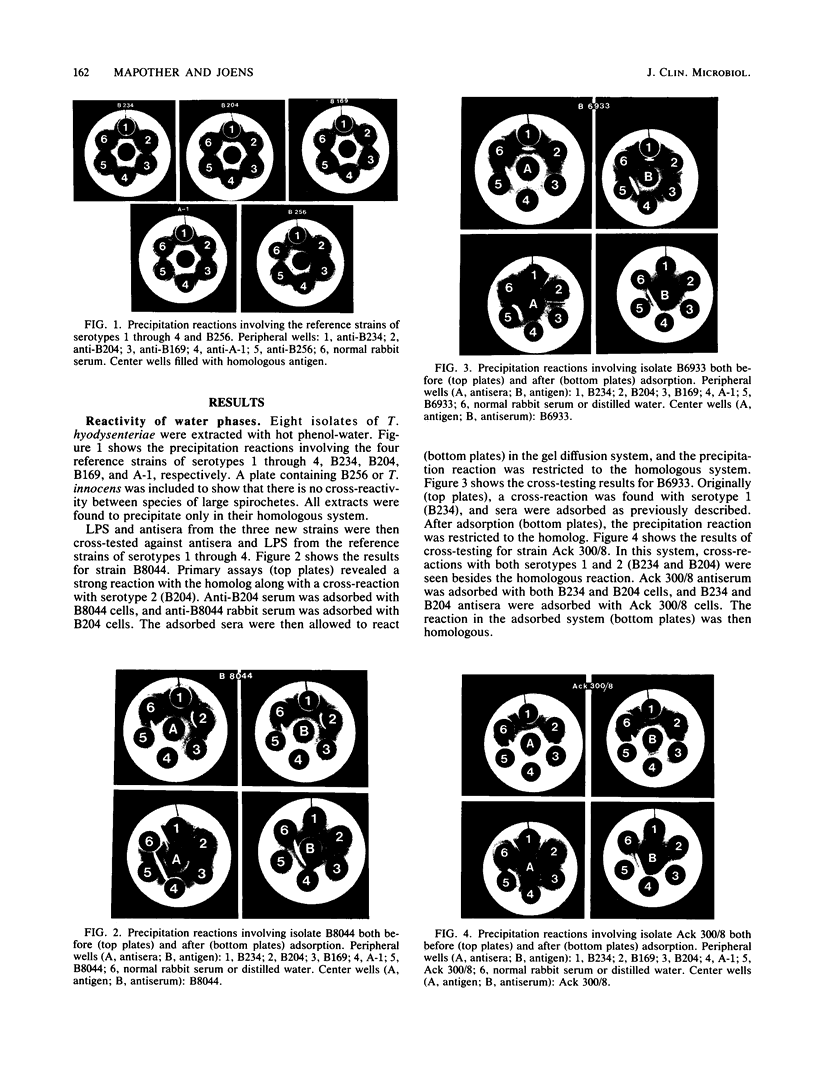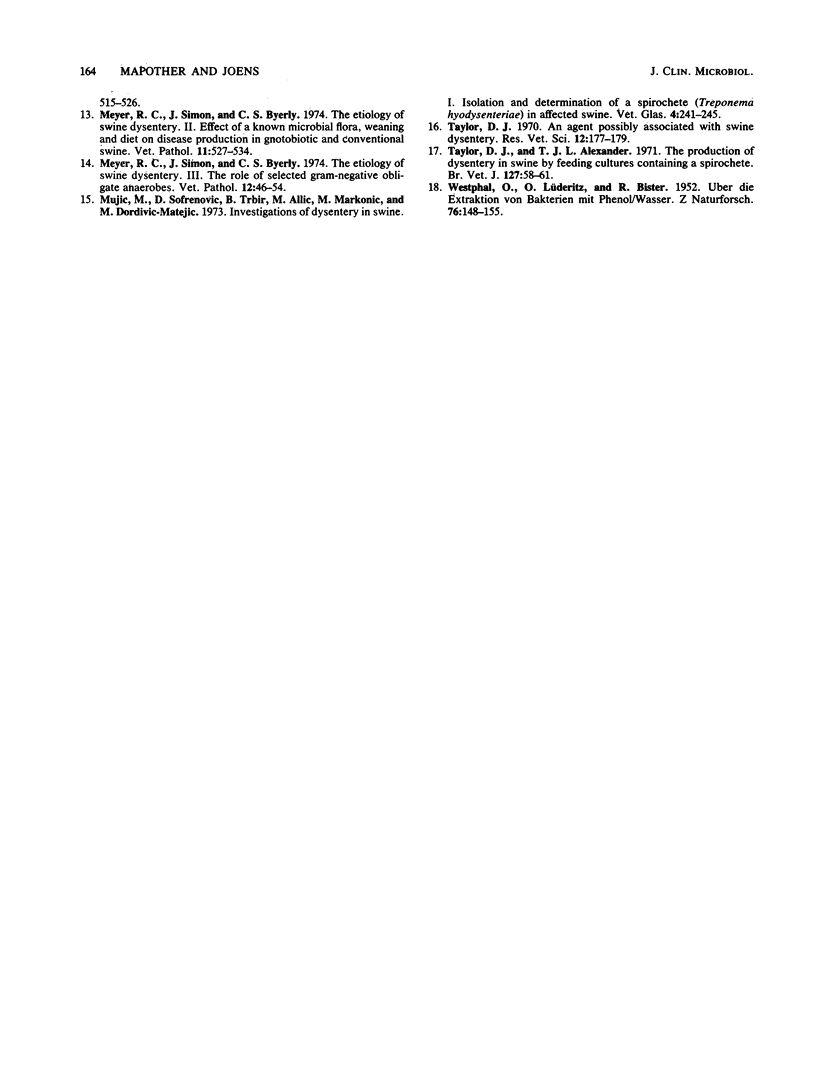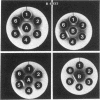Abstract
Three isolates of pathogenic Treponema hyodysenteriae, B8044, B6933, and Ack 300/8, were serotyped by double immunodiffusion using lipopolysaccharide antigen and rabbit antiserum. The precipitation reactions of these three isolates were then compared with precipitin reactions from the reference strains of serotypes 1 through 4. The data indicated that B8044, B6933, and Ack 300/8 share antigenic determinants with either serotype 1 or 2 or both. However, when the cross-reacting antibodies were removed by adsorption, all reactions were found to be monospecific. Based on these results, three new serotypes of pathogenic T. hyodysenteriae are proposed: B8044 serotype 5, B6933 serotype 6, and Ack 300/8 serotype 7.
Full text
PDF



Images in this article
Selected References
These references are in PubMed. This may not be the complete list of references from this article.
- Baum D. H., Joens L. A. Serotypes of beta-hemolytic Treponema hyodysenteriae. Infect Immun. 1979 Sep;25(3):792–796. doi: 10.1128/iai.25.3.792-796.1979. [DOI] [PMC free article] [PubMed] [Google Scholar]
- Goudswaard J., Cornelisse J. L. The agent possibly associated with swine dysentery and the antigenic relationship with Borrelia canis. Vet Rec. 1973 May 26;92(21):562–563. doi: 10.1136/vr.92.21.562. [DOI] [PubMed] [Google Scholar]
- Harris D. L. Current status of research on swine dysentery. J Am Vet Med Assoc. 1974 Apr 15;164(8):809–812. [PubMed] [Google Scholar]
- Harris D. L., Glock R. D., Christensen C. R., Kinyon J. M. Inoculation of pigs with Treponema hyodysenteriae (new species) and reproduction f the disease. Vet Med Small Anim Clin. 1972 Jan;67(1):61–64. [PubMed] [Google Scholar]
- Hughes R., Olander H. J., Williams C. B. Swine dysentery: pathogenicity of Treponema hyodysenteriae. Am J Vet Res. 1975 Jul;36(7):971–977. [PubMed] [Google Scholar]
- Joens L. A., Kinyon J. M. Isolation of Treponema hyodysenteriae from wild rodents. J Clin Microbiol. 1982 Jun;15(6):994–997. doi: 10.1128/jcm.15.6.994-997.1982. [DOI] [PMC free article] [PubMed] [Google Scholar]
- Kinyon J. M., Harris D. L., Glock R. D. Enteropathogenicity of various isolates of Treponema hyodysenteriae. Infect Immun. 1977 Feb;15(2):638–646. doi: 10.1128/iai.15.2.638-646.1977. [DOI] [PMC free article] [PubMed] [Google Scholar]
- Kinyon J. M., Harris D. L. Growth in Treponema hyodysenteriae in liquid medium. Vet Rec. 1974 Sep 7;95(10):219–220. doi: 10.1136/vr.95.10.219. [DOI] [PubMed] [Google Scholar]
- Meyer R. C., Simon J., Byerly C. S. The etiology of swine dysentery. II. Effect of a known microbial flora, weaning and diet on disease production in gnotobiotic and conventional swine. Vet Pathol. 1974;11(6):527–534. doi: 10.1177/030098587401100607. [DOI] [PubMed] [Google Scholar]
- Meyer R. C., Simon J., Byerly C. S. The etiology of swine dysentery. III. The role of selected gram-negative obligate anaerobes. Vet Pathol. 1975;12(1):46–54. doi: 10.1177/030098587501200107. [DOI] [PubMed] [Google Scholar]
- Taylor D. J., Alexander T. J. The production of dysentery in swine by feeding cultures containing a spirochaete. Br Vet J. 1971 Nov;127(11):58–61. doi: 10.1016/s0007-1935(17)37282-2. [DOI] [PubMed] [Google Scholar]
- Taylor D. J., Blakemore W. F. Spirochaetal invasion of the colonic epithelium in swine dysentery. Res Vet Sci. 1971 Mar;12(2):177–179. [PubMed] [Google Scholar]








